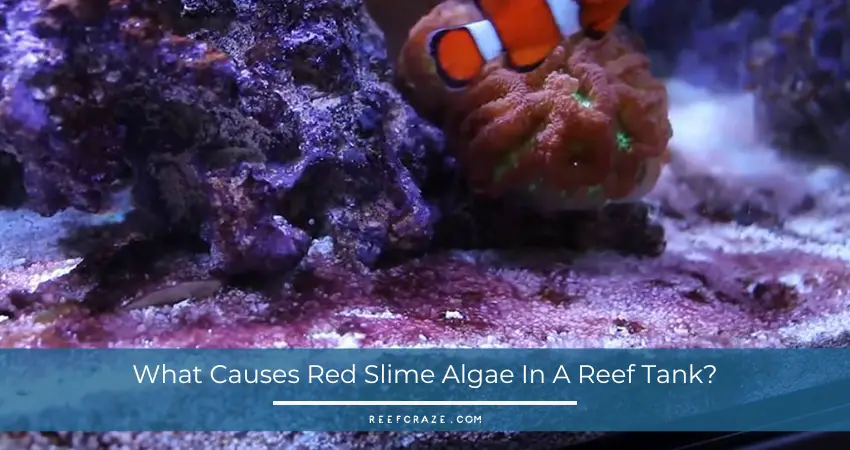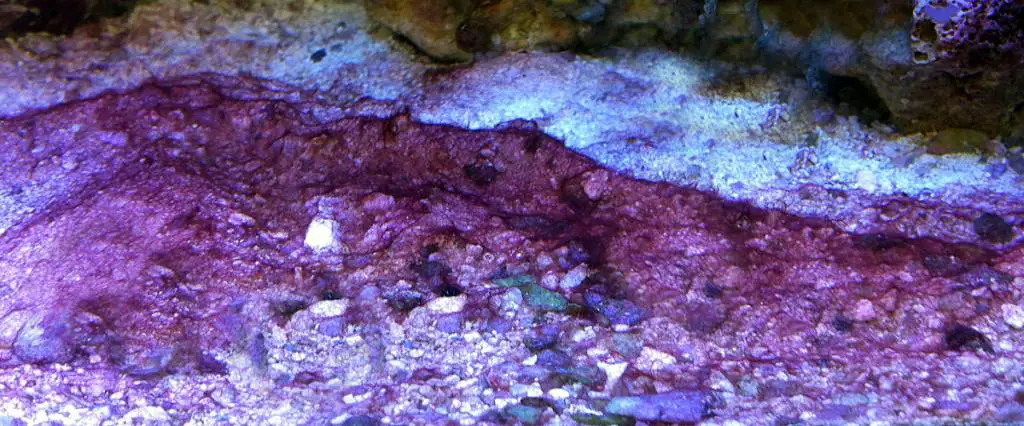Having a reef tank is challenging for a lot of reasons. Since there is life in the water, something will always go on, requiring you to stay alert. One such thing to make you lose your sleep is red slime. If you leave it to flourish, it will coat live rock, substrate, and sessile invertebrates, becoming a battle for you. This might make you wonder what causes red slime algae in a reef tank in the first place?
Nitrates, phosphates, and dissolved organic components are mostly responsible for red slime. Other than them, hypersalinity can also be the reason.
I will explain from the core question, telling you what it is. Following that, there will be cures and prevention methods. Let’s get down to it now, shall we?
What Is Red Slime Algae?

Red Slime Algae is cyanobacteria containing red pigments. Typically categorized as blue-green algae, it comes in different colors.
Researchers think it to be one of the plants that first began surviving by performing photosynthesis and creating an atmosphere enriched with oxygen.
What Causes Red Slime Algae In A Reef Tank?
Like many aquarium nuisances, red slime uses the poor quality of tank water to populate quickly. All it needs is a single cell to make a jungle of algae. You already know what causes red slime algae in a reef tank. Let’s get to the deets now.
Phosphates
Phosphates usually occur in water sources, playing a vital role in building homes for hard corals. If you have no corals but use coral-specific saltwater mixes, you can lower the phosphate level by changing to non-coral solutions. That way, when there are fewer phosphates, the red slime population will begin to subside.
Nitrate
Nitrate is the last stage of the nitrogen cycle. It is safe in a lower quantity, but excessive nitrates can be detrimental to fish while helping red slime burgeon.
You can remove nitrates by changing your tank water. That is something you cannot get behind on. Lack of proper maintenance is the first instigator to cause red slime.

Cyanobacteria rely heavily on light to grow like every photosynthesizing life. Red slime specifically requires a spectrum range between 560 and 620. You can control the red slime growth by changing your lighting system accordingly. But do not reduce the light level so much that it hurts other photosynthesizers like zooxanthellae.
Hypersalinity
Hypersalinity is not a highly likely cause, but I would still advise you to pay attention. It typically takes place when a reefer tops off the evaporation using saltwater.
You may find it unreasonable, but you need to top off your saltwater systems with freshwater. Let me explain it. The salt particles stay behind and cause increased salinity during evaporation.
So, if you add more saltwater, it will result in hypersalinity. You will see red slime building home in your tank when that happens. The solution is pretty simple. You top off using freshwater, keep the salinity optimum, and test it twice or thrice a week via a refractometer.
Other Than That…
You will find some effective antibiotics in the market. However, they can wipe out your tank’s biological filtration. They only work as well as Band-Aids. If you are not attentive to the other predisposing variables, the red slime will return anyway.
The first thing to do when you notice red slime in your tank is to look for the water parameter that has caused its growth. Once you accomplish that, start siphoning it out. You can use a small airline suction tube to explore the tight crevices and spaces.
Remove the slime as best as you can. Leaving one cell can grow bushes of algae in the tank.
Warning
Always make sure that you dispose of the red slime safely. The compound, varying in its composition and species, can be harmful to animals, i.e., dogs.
Never pile up the slime in your backyard. Dump it somewhere your dog and kids cannot access.
How Can I Prevent Red Slime Algae From Growing In My Tank?
The most effective way to prevent red slime algae from growing in your tank is to continue with the regular saltwater tank maintenance routine. If you miss a few water changes, it will give the bacteria a chance to grow and overrun the reef system.
Look for the best saltwater mix for your aquarium. If there are no hard corals, you will not need coral-specific mixes. It will efficiently minimize the phosphates levels.
The second most important approach is to arrange a proper lighting system for your aquarium. It mainly depends on the other photosynthesizers, especially corals.
Whatever you do, do not throw antibiotics there. It is not a lasting solution. Plus, you will have to start the nitrogen cycle from the beginning. Once you learn the predisposing determinants responsible for breeding red slime algae, you will get rid of them for real.
What Else To Do?
Apart from the approaches I discussed above, you can resort to the following.
Keeping The Filtration Media Clean
If your tank has a mechanical filtration like a pre-filter sponge or a filter sock on the pump, make sure it is free of leftover food, detritus, and debris.
It can be an indicator that your filter is functioning. Or it could also be that any component being pushed back into the ink can raise the nutrient levels.
Keeping A High Water Flow
Low water flows make red slime grow faster. You can prevent that from happening by keeping the water flowing up.
Also, get one or two powerheads in the tank to increase the flow. As long as the water moves faster, it will keep the slime growth at bay.
Cutting Back On Feeding The Animals
When you see red slime growing inside your tank, notice if you are feeding your pets too much. Leftover food can fuel the algae problem.
So, if you are giving your buddies too much food out of love, stop it. It will only cause them more harm when the red slime issue becomes more severe.
Final Words
There is no shortcut to keeping your tank free of red slime algae. But if you ask for a single suggestion, it would be to keep your tank clean – squeaky clean. Everything needs to be neat – from the water to the sump and its components.
Once you do that, you won’t lose your sleep over fighting against red slime. And your aquatic pets will also live a peaceful life.
That is all for today. Thank you for reading.

